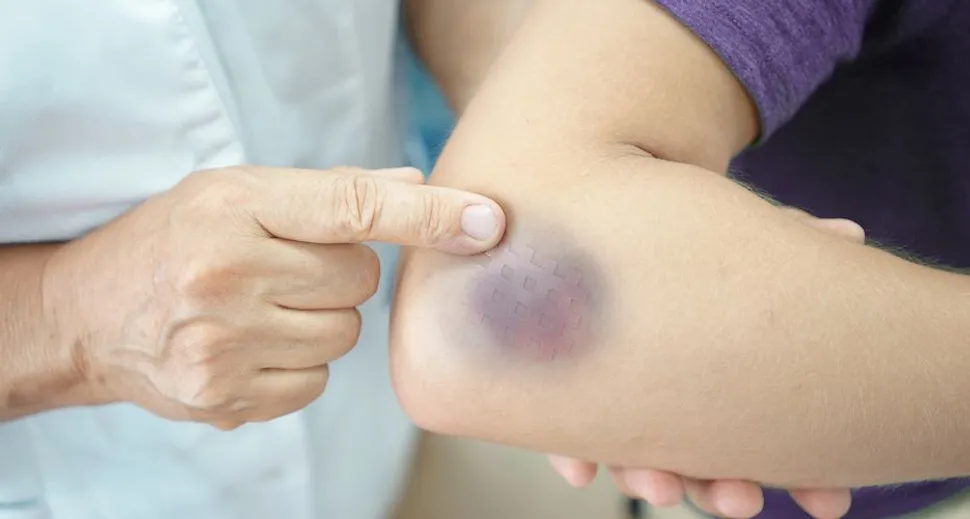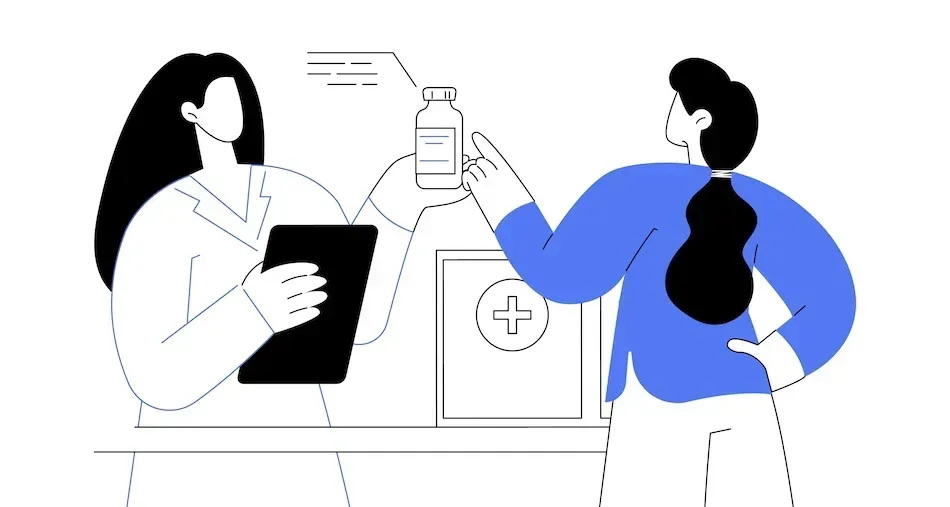CLL Side Effect Management: Bruising

CLL patients often experience higher rates of bruising as a result of the disease or some of its treatments. A study showed that 24% of leukemia patients reported frequent bruising before their diagnosis. In this article, we’ll discuss reasons for that and ways you may be able to manage bruising with your healthcare team.
What is Bruising?
Bruising occurs when the small blood vessels under the skin break. This damage causes blood to leak into the surrounding tissues, leading to a visible discoloration. Initially, a bruise may appear as a reddish mark that turns blue or dark purple over time and eventually yellow or green as the body heals and reabsorbs the blood.
Most of the time, bruising occurs due to an injury such as a fall. However, because of the nature of CLL and its treatments, the incidence of bruising can be higher for CLL patients. Patients may see frequent bruises appear without injuries, and the bruises may be seen in uncommon places such as the back, legs, or hands.
Why Do CLL Patients Experience More Bruising Than Other People?
Over time, CLL cells can crowd out other types of healthy blood cells as they do not die when they should. The type of blood cells that stop bleeding are called platelets. If you do not have enough platelets, a condition known as thrombocytopenia, bruises may occur more frequently and take longer to heal.
Your doctor will regularly check your platelet levels and evaluate if this is the cause of your bruising. A healthy platelet level ranges from 150,000 to 450,000 platelets per microliter of blood. If your platelets are low, you may need to receive a platelet transfusion from a donor.
What is a Platelet Transfusion?
A platelet transfusion is a medical treatment in which platelets are infused into a patient's bloodstream to aid in clotting. It is typically used for those with low platelet counts or platelet dysfunction.
The platelets used in transfusions are usually collected from donors through a process called apheresis. In this process, blood is drawn from the donor and passed through a machine that separates the platelets while returning other blood components back to the donor. This method allows for the collection of a large number of platelets from a single donation, making it highly effective for gathering sufficient platelets for therapeutic use.
What to Expect When Receiving a Platelet Transfusion:
- You’ll first receive a compatibility test to ensure the donor platelets match your blood type and are safe to transfuse.
- Once compatibility is confirmed, the platelets will be administered intravenously in a clinical setting like a hospital or outpatient clinic, a process that usually takes less than 30 minutes to complete.
- During the transfusion, medical staff will closely monitor you to review any possible side effects, such as fever, chills, or allergic responses. If you experience side effects, advise your care team to receive supportive measures.
- After the transfusion, your platelet count and overall response will be assessed to determine the effectiveness of the treatment.
Do CLL Patients Experience Bruising While On Treatment?
If you are taking a CLL medicine called a BTK inhibitor (acalabrutinib [Calquence], zanubrutinib [Brukinsa], or ibrutinib [Imbruvica]), bruising is a common side effect as the medicine interferes with platelet function. If you experience high amounts of bruising while taking a BTK inhibitor and the bruises are not healing within two weeks, tell your doctor so they can consider extra measures to help you recover.
The percentage of CLL patients who reported bruising that healed within two weeks varied for each BTK inhibitor:
- 49% of patients taking ibrutinib
- 21% of patients taking acalabrutinib
- 16% of patients taking zanubrutinib
How Can I Treat Bruises at Home?
If your platelet levels are within a healthy range, other measures to help your bruise heal may include:
- Within 48 hours of the bruise’s appearance, apply an ice pack wrapped in a thin towel to the bruised area for 20 minutes, several times throughout the day. This may help reduce pain and swelling.
- Two days after the bruise’s first appearance, apply a heating pad or warm compress on the bruise several times throughout the day.
- Elevate the bruise above heart level if able.
- Consult with your medical team if you need to take a nonprescription pain reliever for pain management. They may suggest one that does not cause blood thinning, such as Tylenol (acetaminophen).
When Should I Call My Doctor About Bruises?
Contact your doctor about your bruises if your experience:
- Unexplained bruising
- Bruises that last longer than two weeks
- Frequent large bruises
- Lump in the bruised area (hematoma)
- Painful swelling
In conclusion, bruising is a side effect that CLL patients may experience throughout their disease journey or its treatments. Reach out to your doctor if you have any concerns to help manage the side effects of bruising. To continue learning about CLL symptoms, visit our 101 page: What are the Signs and Symptoms of CLL?
Join the HealthTree CLL Chapter!
We invite you to join the HealthTree CLL Chapter by clicking on the button below to gain the benefit of participating in virtual events that cover various CLL topics with experts.
CLICK HERE TO JOIN THE CLL CHAPTER
Sources
- Management of Thrombocytopenia in Patients With Leukemia
- Low-Dose Btk Inhibitors Selectively Block Platelet Activation by CLEC-2
- Brukinsa Prescribing Information
- Calquence Full Prescribing Information
- Imbruvica Prescribing Information
- What Are Platelets and Why Are They Important?
- Bruises (Ecchymosis)
- Chronic Lymphocytic Leukemia
- Bruise: First Aid
- Bruising in Leukaemia VS Ordinary Bruising
- Transfusion Steps and Possible Side Effects
- Component Compatibility
CLL patients often experience higher rates of bruising as a result of the disease or some of its treatments. A study showed that 24% of leukemia patients reported frequent bruising before their diagnosis. In this article, we’ll discuss reasons for that and ways you may be able to manage bruising with your healthcare team.
What is Bruising?
Bruising occurs when the small blood vessels under the skin break. This damage causes blood to leak into the surrounding tissues, leading to a visible discoloration. Initially, a bruise may appear as a reddish mark that turns blue or dark purple over time and eventually yellow or green as the body heals and reabsorbs the blood.
Most of the time, bruising occurs due to an injury such as a fall. However, because of the nature of CLL and its treatments, the incidence of bruising can be higher for CLL patients. Patients may see frequent bruises appear without injuries, and the bruises may be seen in uncommon places such as the back, legs, or hands.
Why Do CLL Patients Experience More Bruising Than Other People?
Over time, CLL cells can crowd out other types of healthy blood cells as they do not die when they should. The type of blood cells that stop bleeding are called platelets. If you do not have enough platelets, a condition known as thrombocytopenia, bruises may occur more frequently and take longer to heal.
Your doctor will regularly check your platelet levels and evaluate if this is the cause of your bruising. A healthy platelet level ranges from 150,000 to 450,000 platelets per microliter of blood. If your platelets are low, you may need to receive a platelet transfusion from a donor.
What is a Platelet Transfusion?
A platelet transfusion is a medical treatment in which platelets are infused into a patient's bloodstream to aid in clotting. It is typically used for those with low platelet counts or platelet dysfunction.
The platelets used in transfusions are usually collected from donors through a process called apheresis. In this process, blood is drawn from the donor and passed through a machine that separates the platelets while returning other blood components back to the donor. This method allows for the collection of a large number of platelets from a single donation, making it highly effective for gathering sufficient platelets for therapeutic use.
What to Expect When Receiving a Platelet Transfusion:
- You’ll first receive a compatibility test to ensure the donor platelets match your blood type and are safe to transfuse.
- Once compatibility is confirmed, the platelets will be administered intravenously in a clinical setting like a hospital or outpatient clinic, a process that usually takes less than 30 minutes to complete.
- During the transfusion, medical staff will closely monitor you to review any possible side effects, such as fever, chills, or allergic responses. If you experience side effects, advise your care team to receive supportive measures.
- After the transfusion, your platelet count and overall response will be assessed to determine the effectiveness of the treatment.
Do CLL Patients Experience Bruising While On Treatment?
If you are taking a CLL medicine called a BTK inhibitor (acalabrutinib [Calquence], zanubrutinib [Brukinsa], or ibrutinib [Imbruvica]), bruising is a common side effect as the medicine interferes with platelet function. If you experience high amounts of bruising while taking a BTK inhibitor and the bruises are not healing within two weeks, tell your doctor so they can consider extra measures to help you recover.
The percentage of CLL patients who reported bruising that healed within two weeks varied for each BTK inhibitor:
- 49% of patients taking ibrutinib
- 21% of patients taking acalabrutinib
- 16% of patients taking zanubrutinib
How Can I Treat Bruises at Home?
If your platelet levels are within a healthy range, other measures to help your bruise heal may include:
- Within 48 hours of the bruise’s appearance, apply an ice pack wrapped in a thin towel to the bruised area for 20 minutes, several times throughout the day. This may help reduce pain and swelling.
- Two days after the bruise’s first appearance, apply a heating pad or warm compress on the bruise several times throughout the day.
- Elevate the bruise above heart level if able.
- Consult with your medical team if you need to take a nonprescription pain reliever for pain management. They may suggest one that does not cause blood thinning, such as Tylenol (acetaminophen).
When Should I Call My Doctor About Bruises?
Contact your doctor about your bruises if your experience:
- Unexplained bruising
- Bruises that last longer than two weeks
- Frequent large bruises
- Lump in the bruised area (hematoma)
- Painful swelling
In conclusion, bruising is a side effect that CLL patients may experience throughout their disease journey or its treatments. Reach out to your doctor if you have any concerns to help manage the side effects of bruising. To continue learning about CLL symptoms, visit our 101 page: What are the Signs and Symptoms of CLL?
Join the HealthTree CLL Chapter!
We invite you to join the HealthTree CLL Chapter by clicking on the button below to gain the benefit of participating in virtual events that cover various CLL topics with experts.
CLICK HERE TO JOIN THE CLL CHAPTER
Sources
- Management of Thrombocytopenia in Patients With Leukemia
- Low-Dose Btk Inhibitors Selectively Block Platelet Activation by CLEC-2
- Brukinsa Prescribing Information
- Calquence Full Prescribing Information
- Imbruvica Prescribing Information
- What Are Platelets and Why Are They Important?
- Bruises (Ecchymosis)
- Chronic Lymphocytic Leukemia
- Bruise: First Aid
- Bruising in Leukaemia VS Ordinary Bruising
- Transfusion Steps and Possible Side Effects
- Component Compatibility

about the author
Megan Heaps
Megan joined HealthTree in 2022. She enjoys helping patients and their care partners understand the various aspects of the cancer. This understanding enables them to better advocate for themselves and improve their treatment outcomes.
More on Navigating Your Health
Trending Articles

Get the Latest Chronic Lymphocytic Leukemia Updates, Delivered to You.
By subscribing to the HealthTree newsletter, you'll receive the latest research, treatment updates, and expert insights to help you navigate your health.
Together we care.
Together we cure.
3x Faster.








